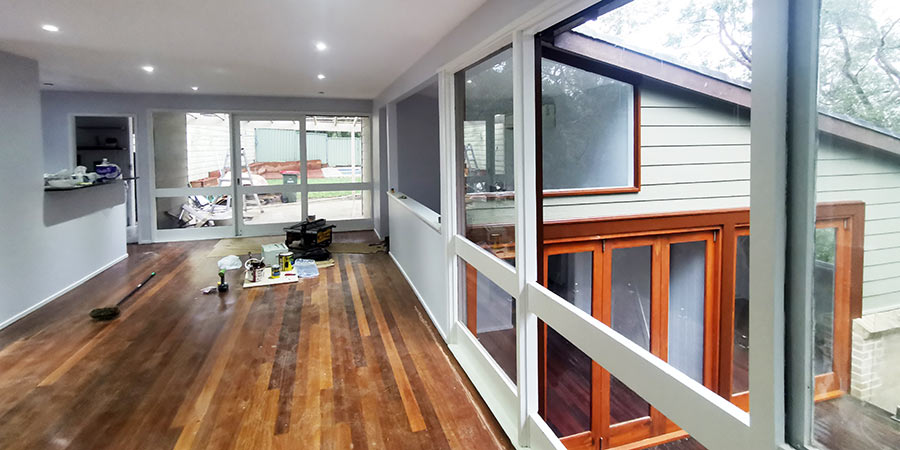When you plan to maintain and refresh your home windows, doors, picture rails, or skirting, using between oil based or water based paint can be a bit hesitate. Typically, oil-based paint, such as Dulux SuperEnamel, can offer a more durable finish. But it has a strong smell during application and can even last 7 days or more. Water-based paint, like Dulux Aquanamel, has only little smell and easy to clean up with water. We’re here to help you better understand the differences between water-based and oil-based paints, so you can pick the right enamel paint for your woodwork painting project.

Different Smell: Water-based vs Oil-based Paint
Oil-based paints emit a stronger odor compared to water-based paints.
Oil-based paints are flammable, and their smell can have more or less harmful impacts on our health. Prolonged exposure to this odor can even cause headaches or skin irritation in some people. In contrast, water-based paints generally release fewer odors.
Why does oil-based paint have a stronger smell than water-based paint? We know that oil-based paints use mineral turpentine in the composition of the paint solvent, while water-based paints mainly use water. Mineral turpentine is a clear, colorless liquid hydrocarbon often referred to as “Turps.” Turps has a very low flashpoint of only 31 ºC and is easy to vaporize, during which it releases chemical oils with odors into the air.
However, we need to be aware that even if we use the highest quality paint, whether oil-based or water-based, there will always be some odor. Therefore, when painting your premises, it is truly necessary to keep all doors and windows open for better ventilation, especially when using oil-based paints.
The smell of Dulux oil-based SuperEnamel typically lasts for one week, while water-based Aquanamel has very little odor and only persists for one or two days.
Different Sheen Qualities: Water-based Paint vs Oil-based Paint
Oil-based paints can achieve a beautiful semi or high gloss sheen finish. However, over time, the gloss finish may become dull or yellow.
Water-based paints generally offer only a low sheen or semi-gloss finish but can maintain this level of shine for a considerably longer period. Some paint companies now provide water-based paints with a high gloss sheen finish. For example, Dulux Aquanamel – gloss can be used as a substitute for traditional oil-based enamels. This not only saves time but also has the added advantage that the paintwork will not turn yellow over time.
Different Durability: Water-based Paint vs Oil-based Paint
Today, most water-based and oil-based enamels are designed to provide a hard-wearing finish suitable for doors, window frames, skirting boards, and architraves.
Oil-based paint has a better performance with better resistance to daily wear and tear and in resisting damage. This is why the oil-base paint doors, window, and skirting are harder to be scratched and can last longer time good finishing.
Water-based Paint: Better for Exterior Use
Water-based paints perform exceptionally well on exterior projects. Primarily, this is because they are significantly more resistant to UV rays, enabling them to retain their sheen and color for extended periods. So Water-based paint is suitable for both painting interior and exterior woodwork surfaces (except for flooring).
In contrast, oil-based paint does not fare as well outdoors. It breaks down UV light and results in a chalky surface.
Difference in Drying Time, but Less Pronounced
In normal weather conditions, water-based paint dries more quickly than oil-based paint. However, the difference is becoming smaller nowadays, particularly on Dulux water based and oil based paints.
Consider the Weather When Painting
Water-based paints do not perform as optimally when applied in damp weather conditions. Lower temperatures and humidity can prolong drying times. High temperatures can cause the paint to dry too rapidly. The drying time of water-based paints, whether too quick or too slow, can have a substantial impact on the paint’s performance and the finished results.
Oil-based paints are much more tolerant of different weather conditions. As a result, humidity and extreme temperatures have a less significant impact on application and drying times.
Humidity also Counts
Water-based paints can tolerate small amounts of humidity on a surface prior to application as the paint can absorb the moisture. Just keep in mind that this can slightly thin the paint but will not affect its ability to bond to the surface.
Oil-based paints repel water and are unable to form a solid bond to the surface. Therefore, any surface to which oil-based paint will be applied must be completely dry before application.
Easy to Clean Up
Water-based paints are undoubtedly easier to clean as the solvent is predominantly composed of water. Painting equipment and brushes can be cleaned with water.
In contrast, oil-based paints require specialty thinners, such as Turps, to clean equipment and brushes.
Don’t Forget the Undercoat
If the old painting surface is oil-based, it is necessary to apply an oil-based undercoat. If the old painting surface is water-based, an undercoat is not necessary, but it is required to sand off dirt or grease before painting.
Oil based undercoats make life easier for very old property
Many very old properties (such as those over 60 years old) have undergone different types of maintenance over the years. In our experience, some windows (or doors, or skirting) may be painted with oil-based paint, while others may be painted with water-based paint. When renovating such an old property, it is better to apply an oil-based undercoat before painting with oil-based enamel or water-based enamel. The oil-based undercoat can better block deep or dirty tints from coming through the top coats and adhere better to old paints. You don’t have to worry about the new top coats coming off in the future.
Hopefully this article can help you choose the right water-based or oil-based paint for your home woodwork maintain job. Before you start your project, we suggest that you talk to the Supahandy Painting & Decorating team. We will be able to answer any questions you may have and help you choose the right paint for your project.
If you are looking for a trusted painter, then contact us to arrange an onsite inspection. Alternatively, complete the online Contact Form and we’ll get back to you shortly.
